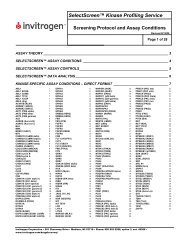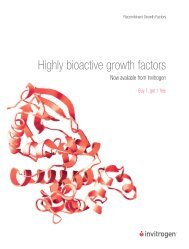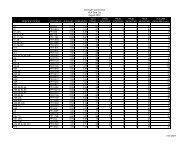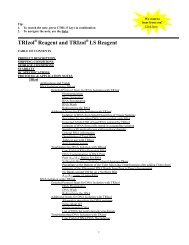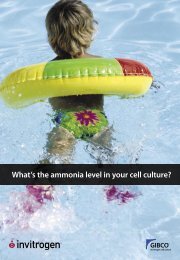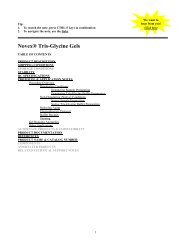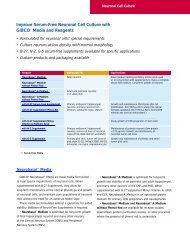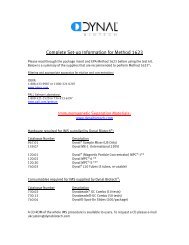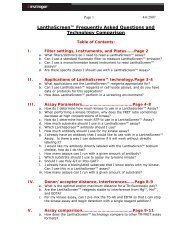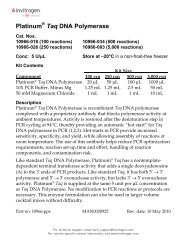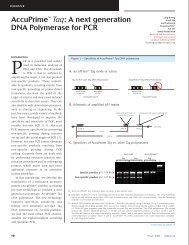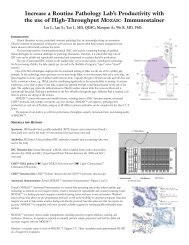Surface Activated Dynabeads.indd - Invitrogen
Surface Activated Dynabeads.indd - Invitrogen
Surface Activated Dynabeads.indd - Invitrogen
You also want an ePaper? Increase the reach of your titles
YUMPU automatically turns print PDFs into web optimized ePapers that Google loves.
•<br />
•<br />
•<br />
A variety of ways to bind your ligand<br />
Manual or automated handling<br />
Protein separation technology<br />
Introduction<br />
<strong>Dynabeads</strong> ® are superparamagnetic monosized polymer<br />
spheres. They are magnetic only when placed in a magnetic<br />
field, with no magnetic remanence when the magnetic field<br />
is removed. <strong>Dynabeads</strong> ® are composed of highly cross-linked<br />
polystyrene with magnetic material precipitated in evenly<br />
distributed pores. The ferrous compound is sealed inside the<br />
bead by an additional layer of polymer. Chemical groups are<br />
then introduced onto the bead surface to facilitate binding<br />
of almost any ligand, and subsequent easy and convenient<br />
isolation of the bound target (fig. 1).<br />
Unique Monodispersity<br />
The unique monodispersity and uniformity<br />
of the <strong>Dynabeads</strong> ® provide optimal and<br />
reproducible reaction kinetics, and a rapid<br />
and efficient binding of target molecules.<br />
<strong>Dynabeads</strong> ® are easily dispersed and<br />
handle almost like a liquid. In addition,<br />
chemical agglutination and nonspecific<br />
binding are negligible as<br />
compared with irregularly shaped<br />
particles.<br />
Hydrophobic or<br />
Hydrophilic<br />
Dynal Biotech provides surface<br />
activated <strong>Dynabeads</strong> ® with<br />
both hydrophobic and hydrophilic<br />
characteristics:<br />
The hydrophilic beads allow<br />
for gentle coupling of ligands<br />
to the surface. The functional<br />
ac tivit y of enz y mes and<br />
labile proteins is therefore<br />
intact after immobilisation.<br />
T he hydrophilic proper ties<br />
of the beads ensure optimal<br />
dispersion in suspension. Very<br />
low nonspecific binding of proteins,<br />
dyes etc. is observed with the pH<br />
neutral M-270 Epoxy beads, thus<br />
the requirement for blocking agents<br />
is reduced. The functional groups of<br />
the M-270 Amine and Carboxylic Acid<br />
beads allow further introduction of a large<br />
variety of alternative reactive groups by using<br />
commercially available cross-linkers.<br />
Fig. 1 Principle of biomagnetic<br />
separation with <strong>Dynabeads</strong> ® .<br />
<strong>Surface</strong> <strong>Activated</strong> <strong>Dynabeads</strong> ®<br />
2<br />
•<br />
•<br />
•<br />
Superior reproducibility<br />
All-in-one-tube protocols<br />
Easy handling and no sample loss<br />
A hydrophobic surface is an excellent choice for coupling of<br />
antibodies for affinity purification of organelles or proteins.<br />
The hydrophobic Fc region of the antibody is adsorbed to the<br />
hydrophobic bead surface, followed by a rapid covalent bond<br />
formation. The orientation of the antibody is optimal, with the<br />
Fab regions facing outwards. The resultant yield of target protein<br />
or organelle fractionation is elevated.<br />
Small or Large, Automation or Manual Handling<br />
Dynal Biotech offers surface activated <strong>Dynabeads</strong> ® of various<br />
sizes. For work with proteins, nucleic acids or similar materials,<br />
we recommend the 1.0 µm (the MyOne TM series) or the 2.8 µm<br />
(the M-280 and M-270 series). The larger 4.5 µm beads are well<br />
suited to isolating larger entities such as organelles or cells.<br />
Due to their size and high iron content they exert a strong pull<br />
to the magnet, even in viscous samples, yet still retain gentle<br />
handling of the bound target. The <strong>Dynabeads</strong> ® are easy to<br />
handle manually using simple magnet racks for the isolation<br />
of target.<br />
<strong>Dynabeads</strong> ® MyOne TM are ideal for isolation of smaller entities<br />
such as proteins and bacteriophages. In addition, the 1.0<br />
µm beads have a large surface area, high capacity, efficient<br />
magnetic pull and excellent properties for automation. The<br />
MyOne TM products are tailor-made for use in automated<br />
protocols where high throughput is crucial. Dynal Biotech<br />
has developed suitable protocols for several of the robotic<br />
workstations available on the market.<br />
Specific Considerations<br />
To obtain the best possible result, it is important to choose the<br />
correct product for your specific application. The table on page<br />
5 will help you decide which product to use. The choice will first<br />
of all depend on the nature of the ligand.<br />
A successful coupling of a ligand to tosylactivated beads<br />
requires primary amino- or sulphydryl groups. The orientation<br />
of the active site of the ligand must also be taken into<br />
consideration. Hydrophobic beads facilitate interactions<br />
between the beads and the hydrophobic parts of the proteins,<br />
whereas the hydrophilic beads are suitable when interactions<br />
between the beads and the hydrophilic parts of the proteins<br />
are desired. If the ligand is a labile peptide or protein, the best<br />
choice is to use beads with epoxy groups allowing for coupling<br />
down to 4°C. Carboxylic acid beads, with which peptide bonds<br />
are formed within minutes, are a satisfactory alternative.<br />
www.dynalbiotech.com



